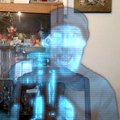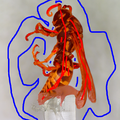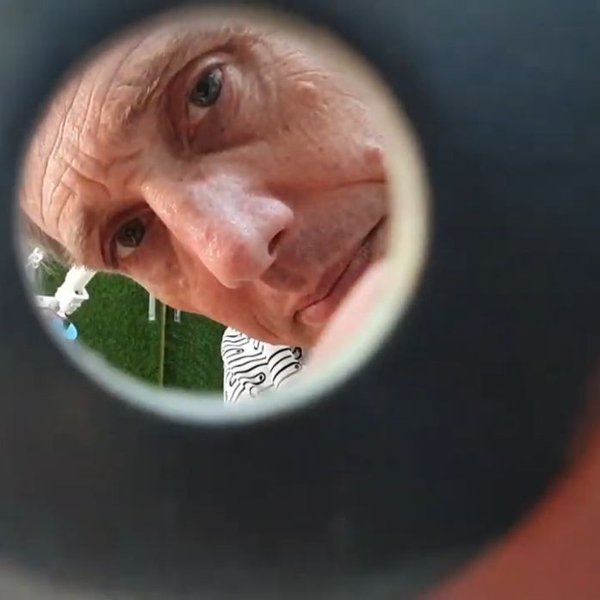Hi everyone, welcome to Hack Chat. I'm Dan, I'll be moderating today, and our guest is Les Wright who has been doing some really interesting stuff with lasers that are leaps beyond diode lasers. Les, are you online yet?
 Hi, Yes, I am here!
Hi, Yes, I am here!
 How is everyone?
How is everyone?
![]() Is it only me that had problem connecting?
Is it only me that had problem connecting?
 Hey there, welcome! Can you start us off with a little about yourself?
Hey there, welcome! Can you start us off with a little about yourself?
 @Nicolas Tremblay - Yeah, things are a bit sluggish today. We have the devs looking into it.
@Nicolas Tremblay - Yeah, things are a bit sluggish today. We have the devs looking into it.
 Yep sure! I have been interested in Science and Electronics since I was a kid. Over the year I have built all the usual HV stuff: Tesla coild, Marx generators, x-ray machines and of course Lasers! I am also interested in ancient computer stuff too.
Yep sure! I have been interested in Science and Electronics since I was a kid. Over the year I have built all the usual HV stuff: Tesla coild, Marx generators, x-ray machines and of course Lasers! I am also interested in ancient computer stuff too.
 Hi Les, Dan and everybody.
Hi Les, Dan and everybody.
 Wait, what's your idea of "ancient"?
Wait, what's your idea of "ancient"?
 *checks mirror, sees gray hair...*
*checks mirror, sees gray hair...*
 LOL late 80's, not ancient ancient, but old!
LOL late 80's, not ancient ancient, but old!
 Erk I meant 70's
Erk I meant 70's
 Cosmac Elf era stuff :-)
Cosmac Elf era stuff :-)
 OK, I feel better now ;-)
OK, I feel better now ;-)
 Oh man, my first computer! First assembler I ever wrote was for the 1802
Oh man, my first computer! First assembler I ever wrote was for the 1802
 But we digress. This is where I first caught on to Les' laser work:
But we digress. This is where I first caught on to Les' laser work:

https://hackaday.com/2020/08/09/how-about-a-nice-cuppa-tea-laser/
How About A Nice Cuppa TEA Laser?
If lasers are your hobby, you face a conundrum. There are so many off-the-shelf lasers that use so many different ways of amplifying and stimulating light that the whole thing can be downright - unstimulating. Keeping things fresh therefore requires rolling your own lasers, and these DIY nitrogen TEA and dye lasers seem like a fun way to go.
 Totally! Any Laser questions?
Totally! Any Laser questions?
![]() Eventually, I would like to build my own CNC laser cutter. Any suggestions, tips, comments?
Eventually, I would like to build my own CNC laser cutter. Any suggestions, tips, comments?
 I have actially never built one, but I will give it a go. What material are you looking to cut?
I have actially never built one, but I will give it a go. What material are you looking to cut?
 Wow, homemade CNC with a homemade laser. a DIY tour de force!
Wow, homemade CNC with a homemade laser. a DIY tour de force!
![]() Thin wood, plywood, acrylic or other plastic
Thin wood, plywood, acrylic or other plastic
 Ah right, then I would go with a CO2 laser for that. Cheap tubes show up on eBay all the time. It's one of those things I keep thinking about. I suppoese you could get away with the high watt blue diodes that show up on eBay lately as well, but safety goggles for that stuff!
Ah right, then I would go with a CO2 laser for that. Cheap tubes show up on eBay all the time. It's one of those things I keep thinking about. I suppoese you could get away with the high watt blue diodes that show up on eBay lately as well, but safety goggles for that stuff!
![]() My first step will be converting my cheap press drill to a 2.5CNC. Just to get my hands wet in building a CNC
My first step will be converting my cheap press drill to a 2.5CNC. Just to get my hands wet in building a CNC
 Are those laser attachments for a 3D printer to do engraving any good? What kind of eye protection should be considered, a box with a protection window or just glasses?
Are those laser attachments for a 3D printer to do engraving any good? What kind of eye protection should be considered, a box with a protection window or just glasses?
![]() What kind of power level would you recommend?
What kind of power level would you recommend?
 @Greg Bushta get safety goggles, and wear them if you are playing with hgh power stuff. I have a real nice project lined up, but I'm notplayong til I have the glasses!
@Greg Bushta get safety goggles, and wear them if you are playing with hgh power stuff. I have a real nice project lined up, but I'm notplayong til I have the glasses!

 @Nicolas Tremblay depends on the thickness of the material. I woudl guess about 5 wats for super thin stuff, than >10w for thicker. The think is to buy based on the thickest material. You can always turn it down for thinner stuff right?
@Nicolas Tremblay depends on the thickness of the material. I woudl guess about 5 wats for super thin stuff, than >10w for thicker. The think is to buy based on the thickest material. You can always turn it down for thinner stuff right?
![]() I really wanted to build that (I was in high school too, senior year) but when I got to the part about sputtering I realized this was not something I was going to get done in time for my senior project. A friend of mine tells me he did build it.
I really wanted to build that (I was in high school too, senior year) but when I got to the part about sputtering I realized this was not something I was going to get done in time for my senior project. A friend of mine tells me he did build it.
 @Dag Spicer aw man, I always wanted to build that too! Loved the Sci-Am stuff!
@Dag Spicer aw man, I always wanted to build that too! Loved the Sci-Am stuff!
 It had salt windows did it not?
It had salt windows did it not?
![]() I was thinking 10-15 watts
I was thinking 10-15 watts
![]() Sure miss that Amateur Scientist column!
Sure miss that Amateur Scientist column!
 Thanks. My neighbor bought a cheap k40 laser cutter and just got his glasses. I'll get some, too.
Thanks. My neighbor bought a cheap k40 laser cutter and just got his glasses. I'll get some, too.
 @Dag Spicer - I remember a dye laser from The Amateur Scientist with two parallel quartz tubes, one for the dye and one for a flash tube. They were inside an aluminum tube slightly squashed into an ellipse to act as a reflector. Always wanted to build that one.
@Dag Spicer - I remember a dye laser from The Amateur Scientist with two parallel quartz tubes, one for the dye and one for a flash tube. They were inside an aluminum tube slightly squashed into an ellipse to act as a reflector. Always wanted to build that one.
![]() Les, are you available to do a (zoom) presentation to a local techup meetup group? PM me and I can provide more info. thank you.
Les, are you available to do a (zoom) presentation to a local techup meetup group? PM me and I can provide more info. thank you.
![]() (Local means north end of Seattle, but with zoom ...)
(Local means north end of Seattle, but with zoom ...)
 @Dan Maloney , yeah I drolled over that as well!
@Dan Maloney , yeah I drolled over that as well!
 @Ken, I will drop you a PM, and see if we can work something out.
@Ken, I will drop you a PM, and see if we can work something out.
![]() Thank you very much.
Thank you very much.

 Yes, kinda exotic, and copper bellows as well. I also always wanted to build the Argon Laser in Sci-Am but lack the glassblowing skills for that one!
Yes, kinda exotic, and copper bellows as well. I also always wanted to build the Argon Laser in Sci-Am but lack the glassblowing skills for that one!

 That's the beauty of the N2 Laser article, no glasswork :-)
That's the beauty of the N2 Laser article, no glasswork :-)
 So what's the lowest hanging fruit for DIY lasers? The nitrogen lasers seem pretty easy, but is there anything easier?
So what's the lowest hanging fruit for DIY lasers? The nitrogen lasers seem pretty easy, but is there anything easier?
 @Dan Maloney I think that is about it. Really cant get much simpler and cheap. YAG and Ruby are easy, just have expensive parts. I suppose you can buy Laser diodes, but that's cheating :-)
@Dan Maloney I think that is about it. Really cant get much simpler and cheap. YAG and Ruby are easy, just have expensive parts. I suppose you can buy Laser diodes, but that's cheating :-)

![]() can you please give us a pointer to getting started wth the nitrogen lasers?
can you please give us a pointer to getting started wth the nitrogen lasers?
 @Ken, sure, in the first instance read the Sci-Am article, for a bit of background. I have some fairly extensive videos up on youtube bout them as well here: Is there anything specific you want to know first?
@Ken, sure, in the first instance read the Sci-Am article, for a bit of background. I have some fairly extensive videos up on youtube bout them as well here: Is there anything specific you want to know first?
 Are those Amateur Scientist articles freely available? I've been paywalled every time I try to get that dye laser article from like 1972
Are those Amateur Scientist articles freely available? I've been paywalled every time I try to get that dye laser article from like 1972
 @Dag Spicer my first laser was a He-Ne laser from a phillips Laserdisk player!
@Dag Spicer my first laser was a He-Ne laser from a phillips Laserdisk player!
 @Dan, I though I saw it somewhere, I will have a dig. I have the book itself at home.
@Dan, I though I saw it somewhere, I will have a dig. I have the book itself at home.
 Tell you what, check out this site: http://technology.niagarac.on.ca/people/mcsele/lasers/LasersN2.htm
Tell you what, check out this site: http://technology.niagarac.on.ca/people/mcsele/lasers/LasersN2.htm
 That is a good starting point!
That is a good starting point!
![]() There's a CD with all the Amateur Scientists articles on it. I have it somewhere, PM me and if I ever find it I can send you the article (no promises on when that might happen!)
There's a CD with all the Amateur Scientists articles on it. I have it somewhere, PM me and if I ever find it I can send you the article (no promises on when that might happen!)
 Hmm -- would it be possible to use double-sided FR4 to make capacitors for N2 lasers? I think you're using acrylic and foil, right?
Hmm -- would it be possible to use double-sided FR4 to make capacitors for N2 lasers? I think you're using acrylic and foil, right?
 @Dan Maloney ugh, yea it is paywalled on Jstor. You coudl always check out Sam's Laser FAQ here: https://www.repairfaq.org/sam/lasercn2.htm Good guy Sam, I worked on a project with him once!
@Dan Maloney ugh, yea it is paywalled on Jstor. You coudl always check out Sam's Laser FAQ here: https://www.repairfaq.org/sam/lasercn2.htm Good guy Sam, I worked on a project with him once!
 @Dan Maloney Yes, it sold as stencil sheet. Acetate I think, with aluminum foil laid on top. I am not sure I would trust FR4
@Dan Maloney Yes, it sold as stencil sheet. Acetate I think, with aluminum foil laid on top. I am not sure I would trust FR4
 FYI, a transcript will be available after the chat if anyone needs to refer back to links, etc.
FYI, a transcript will be available after the chat if anyone needs to refer back to links, etc.
 Vastly different dielectric constants, I'd imagine
Vastly different dielectric constants, I'd imagine
![]() non constant dielectric with FR4
non constant dielectric with FR4
 Yes, and thin enough pcb's are hard to come by as well. I saw as TEA laser built oe with Kapton Flex PCB, but it is very expensive stuff!
Yes, and thin enough pcb's are hard to come by as well. I saw as TEA laser built oe with Kapton Flex PCB, but it is very expensive stuff!
 @Nicolas Tremblay - Why is that? Is the material not homegenous or something?
@Nicolas Tremblay - Why is that? Is the material not homegenous or something?
![]() It's woven fiberglass, so not constant density
It's woven fiberglass, so not constant density
 @LesWright I'm having a look at Sam's FAQ at the moment, looks like he used to have links to the SciAm articles but the link's dead now! (Also, I'm jealous you got to work with him!!)
@LesWright I'm having a look at Sam's FAQ at the moment, looks like he used to have links to the SciAm articles but the link's dead now! (Also, I'm jealous you got to work with him!!)
 PCB's may also have bubbles in the PCB, which will form corona under HV stress, and eat itself.
PCB's may also have bubbles in the PCB, which will form corona under HV stress, and eat itself.
![]() It was something I picked up in the Hack Chat about high frequency circuits
It was something I picked up in the Hack Chat about high frequency circuits
 You woudl be surprised what works though.
You woudl be surprised what works though.

 See the big one at the back? That is the latest :-)
See the big one at the back? That is the latest :-)
 How easy are those dorrknob caps to come by?
How easy are those dorrknob caps to come by?
 They show up occasionally on eBay, but they are pretty pricey! I pulled these out of an old Marx Gen project I built back in the day! I'm going to see what we can get away with now. I have some old russian doorkobs that are cheap as chips that I want to try.
They show up occasionally on eBay, but they are pretty pricey! I pulled these out of an old Marx Gen project I built back in the day! I'm going to see what we can get away with now. I have some old russian doorkobs that are cheap as chips that I want to try.
 I am also curious if something can be done with regular wire ended ceramics. Im still figuring out how to de-pot them without cracking the dielectric.
I am also curious if something can be done with regular wire ended ceramics. Im still figuring out how to de-pot them without cracking the dielectric.
 Of course, you could build the regular LC inversion design ond forego the doorknobs.
Of course, you could build the regular LC inversion design ond forego the doorknobs.

 What are the bars perpendicular to the channel?
What are the bars perpendicular to the channel?
 @Dan Maloney they are just clamps to hold the channel firm against the foil. These things just love a good connection, and they really perform what you clamp stuff down.
@Dan Maloney they are just clamps to hold the channel firm against the foil. These things just love a good connection, and they really perform what you clamp stuff down.
 All this started from this:
All this started from this:

![]() Can you please fill in us newbies what this is all about with the doorknobs, etc.? I assume something about high power high frequency power supplies.
Can you please fill in us newbies what this is all about with the doorknobs, etc.? I assume something about high power high frequency power supplies.
 @Ken Berkun so there are two designs for N2 lasers. The LC inversion circuit like the Sci Am design, or the Charge transfer circuit with the doorknobs. There are pros and cons for each, which I talk about in this video: In short the Charge transfer design has a much longer life, and you can drive it harder. That catch beig doorknobs are expensive.
@Ken Berkun so there are two designs for N2 lasers. The LC inversion circuit like the Sci Am design, or the Charge transfer circuit with the doorknobs. There are pros and cons for each, which I talk about in this video: In short the Charge transfer design has a much longer life, and you can drive it harder. That catch beig doorknobs are expensive.
![]() Thank you, I'll check out the video.
Thank you, I'll check out the video.
 Im just having a root to see if I can find schematics...
Im just having a root to see if I can find schematics...
 Semi-related, any recommendations of scrounging/scavenging for laser components and accessories?
Semi-related, any recommendations of scrounging/scavenging for laser components and accessories?
 How much are the doorknobs in $?
How much are the doorknobs in $?
 I see a wide range in eBay right now. $9.50 for a 40 kV 570 pF TDK, only one available though
I see a wide range in eBay right now. $9.50 for a 40 kV 570 pF TDK, only one available though
 @gmp9 depends how crafty you are at eBay! Sometimes more that $30 each, but occasionaly a bargain can be had. I have "tdk capacitors" in my search
@gmp9 depends how crafty you are at eBay! Sometimes more that $30 each, but occasionaly a bargain can be had. I have "tdk capacitors" in my search
 It's a waiting game.
It's a waiting game.
 @Ken Berkun thought I had schematics, but they are in the video in any case!
@Ken Berkun thought I had schematics, but they are in the video in any case!
 Lot of 5 Murata 20 kV 701 pF for $40
Lot of 5 Murata 20 kV 701 pF for $40
 Probably fine at that. The voltage rating is a little on the low side, but doorknobs are quite hardy...
Probably fine at that. The voltage rating is a little on the low side, but doorknobs are quite hardy...
 Yeah, I thought 20 kV was a little low for what you're doing
Yeah, I thought 20 kV was a little low for what you're doing
 My latest design has 6 doorknobs in it for a 30cm long channel. Not much point scaling it up any more though in any case. This one is being driven at 23kV, the smaller ones are driven at 17kV
My latest design has 6 doorknobs in it for a 30cm long channel. Not much point scaling it up any more though in any case. This one is being driven at 23kV, the smaller ones are driven at 17kV
 What are the specs on your doorknobs?
What are the specs on your doorknobs?
 Are you still using hex stock for the electrodes? If so, how hard is it to align those over such a long length?
Are you still using hex stock for the electrodes? If so, how hard is it to align those over such a long length?
 Missed most of the chat, just saying hi to @LesWright, hope you get your old X-Ray art and other stuff up here soon :)
Missed most of the chat, just saying hi to @LesWright, hope you get your old X-Ray art and other stuff up here soon :)
 @Dan Maloney yes, in the latest version hex stock, except bigger this time (10mm across flats) so easier to work with. Its not to bad aligning them to be honest. The rail bolted to the baseplate is problematic, as if you nip up the bolts too tight, it tends to twist the mar somewhat.
@Dan Maloney yes, in the latest version hex stock, except bigger this time (10mm across flats) so easier to work with. Its not to bad aligning them to be honest. The rail bolted to the baseplate is problematic, as if you nip up the bolts too tight, it tends to twist the mar somewhat.
 @Ahron Wayne hello again! It is in progress :-)
@Ahron Wayne hello again! It is in progress :-)

 Hooray!
Hooray!
 Here is a close up! I reckoon this thing puts out close to a millijoule. So a Megawatt or there abouts -D
Here is a close up! I reckoon this thing puts out close to a millijoule. So a Megawatt or there abouts -D
 I hate to do it, but we've been going for an hour so I have to call time. The conversation can always continue here, but we have to let Les get back to the lab if he needs to. I just want to say a huge thanks to Les for coming on today and taking our questions, and to everyone for participating. Thanks, all!
I hate to do it, but we've been going for an hour so I have to call time. The conversation can always continue here, but we have to let Les get back to the lab if he needs to. I just want to say a huge thanks to Les for coming on today and taking our questions, and to everyone for participating. Thanks, all!
 Yes, thanks everyone! As always, I will keep making stuff, so check me out from time to time!
Yes, thanks everyone! As always, I will keep making stuff, so check me out from time to time!
 Thanks Les!
Thanks Les!
 Thank you.
Thank you.
 Thanks!
Thanks!
 And thanks for the great videos too, always informative!
And thanks for the great videos too, always informative!
![]() Thank you! I'll keep an eye out for your PM.
Thank you! I'll keep an eye out for your PM.
 Thanks Les.
Thanks Les.
 You are all very welcome! @Ken Berkun I will PM you in a short while.
You are all very welcome! @Ken Berkun I will PM you in a short while.
 And don't forget next week we'll have Leo Fernekes on:
And don't forget next week we'll have Leo Fernekes on:

https://hackaday.io/event/175236-harnessing-your-creativity-hack-chat
Harnessing Your Creativity Hack Chat
Leo Fernekes will host the Hack Chat on Wednesday, October 14, 2020 at noon Pacific Time. Time zones got you down? Here's a handy time converter! You're sitting at your bench, surrounded by the tools of the trade -- meters and scopes, power supplies and hand tools, and a well-stocked parts bin.
 Cool! I think I will come along to that one too!
Cool! I think I will come along to that one too!
 Cool. Leo has a unique take on the creative process, really like his style.
Cool. Leo has a unique take on the creative process, really like his style.
 Dan Maloney
Dan Maloney

Discussions
Become a Hackaday.io Member
Create an account to leave a comment. Already have an account? Log In.